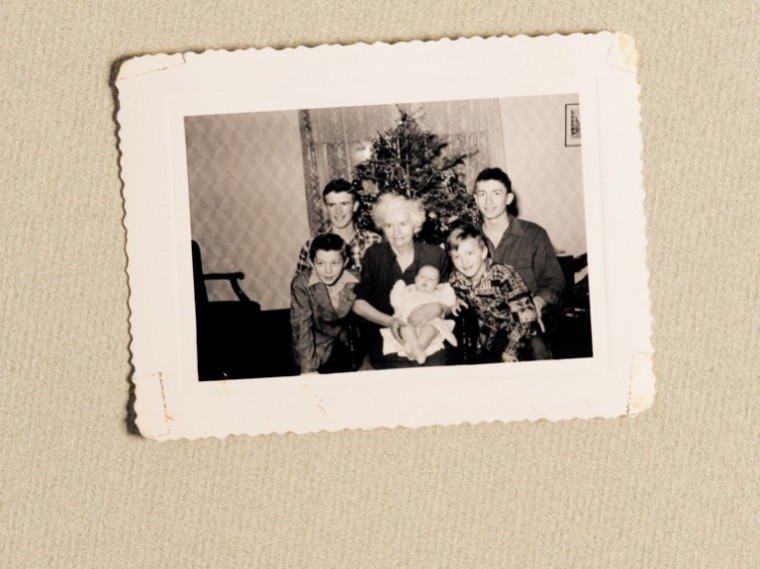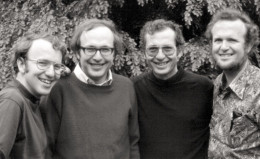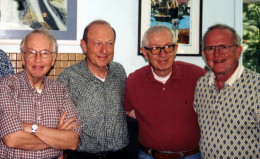Four Doctors, One Remarkable Family
Open gallery

by Sylvia Lindman
During World War II, young Bill Sack overheard his father, a military chaplain, counseling people who were troubled by the big issues of life: war, marriage, family. “This was a part of my father I had not seen before that intrigued me,” Bill recalls.
Although his father’s ministry piqued Bill’s interest in both the mysteries of human nature and a life of service, Bill deliberately chose a different path, charting a course his three younger brothers would follow.
The boys were born and educated in small towns throughout the Midwest and South. In 1952, just as the two oldest were ready for college, the family arrived in Oregon. After checking out other local options, Bill and Brad Sack enrolled at Lewis & Clark College. It was philosophically moderate enough to please their parents and close enough that they could live at home. And, thanks to scholarships and jobs, it was affordable.
All four Sack brothers eventually earned their BS degrees at Lewis & Clark. And all went on for MDs at the University of Oregon Medical School (now Oregon Health & Science University, or OHSU). Two of them–Bill ’56 and Bob ’64–became psychiatrists. The other two, Brad ’56 and David ’65–became specialists in internal medicine and tropical diseases. Their younger sister, Kathy, is a nurse midwife.
The similarities don’t end there. As physicians, all four Sack brothers have had an impressive impact in alleviating suffering and improving people’s lives around the world. Cumulatively, they have practiced medicine for more than 160 years, published approximately 400 research papers, and helped train hundreds of doctors now working in the United States and abroad.
Each chose not only medicine but academic medicine. This research-oriented career is often less lucrative than private practice but potentially more influential, since it is through research that medicine advances.
The Sack brothers felt no family pressure to go into medicine. “We all had our individual reasons,” says Bob, who initially thought about studying engineering. “But by the time I had to make up my mind about a major, I had two older brothers in medical school, and I felt their excitement.” Each, in his own way, became a role model for the next.
|
David Sack ’65 International Health, Johns Hopkins and Bangladesh As executive director of the Bangladesh research center, David oversees major research projects related to child survival, reproductive health, nutrition, low birth weight, and population.
Wife: Jean Sack ’67 |
Robert “Bob” Sack ’64 Psychiatry, OHSU Bob is an internationally recognized leader in sleep research. First wife: Leslie Sack ’65 (died in 1996) Children: Heather and Sydney Second wife: Corinna Campbell-Sack |
William “Bill” Sack ’56 Psychiatry, OHSU Bill, a pioneer in the field of child psychiatry, has done influential studies of psychiatric disorders among Native American children and Cambodian adolescent refugees.
Wife: Susan Sack ’59 |
Bradley “Brad” Sack ’56 International Health, Johns Hopkins Brad is an expert in infectious diarrheal diseases, a major killer of infants and children in the developing world. Wife: Jo Sack Children: Collette, Dan, James, and Jonathan |
Bill Sack
Professor Emeritus of Psychiatry, Oregon Health & Science University
Bill Sack is a respected child psychiatrist who is especially well known for his studies of Cambodian refugees. But when he was a medical student, his chosen specialty barely existed.
Because OHSU had no child psychiatry program, Bill became a pediatrician. After working in San Francisco and Portland, he moved to Browning, Montana, near Glacier Park, to fulfill his military requirement with the U.S. Public Health service’s Division of Indian Health. Wherever he went, his young patients’ mental health problems concerned him. “I don’t know the exact statistics,” he says, “but probably 5 to 8 percent of kids have some mental health needs. A lot of them have a combination of medical and mental health needs, and they need a physician to be involved in their diagnosis and treatment.”
It took time, determination, and a detour to Boston for Bill to acquire a specialty in child psychiatry. First, he completed a residency in adult psychiatry at OHSU. Then he got the chance to work under Leon Eisenberg, a noted child psychiatrist who was chief of psychiatry at Harvard’s Massachusetts General Hospital. Bill did so well there that he was offered a job, but he turned it down. “The pull westward was too strong,” he said.
That was lucky for Oregon. Bill joined the OHSU faculty in 1973 as an assistant professor of psychiatry and pediatrics. In 1975, he says, “I was suddenly kicked upstairs to become director of the new division of child psychiatry, a post I held for 22 years.” Now, while continuing to teach part time as a professor emeritus, Bill also consults regularly with the Morrison Center and the McLaren School for Boys in Portland.
Bill is proud that his work has increased the number of child psychiatrists in Oregon –from about six when his OHSU program began to more than 60 today.
He is also proud of his research among Native American children and Cambodian adolescent refugees. Bill followed many Cambodian children from shortly after they fled Pol Pot’s regime through young adulthood in Oregon. His research illuminated not only the terrors they had endured but also their profound resilience.
Moreover, the research confirmed his faith in the field he had always believed in: child psychiatry.
Brad Sack
Professor of International Health, Johns Hopkins Bloomberg School of Public Health
Born in 1935, Brad is a year younger than Bill but was the first Sack brother to announce his plans to become a doctor. “When I was about 5 years old,” he says, “I’d visit my grandmother in Iowa who had such affection for her own doctor. She’d drive me by the hospital and say, ‘Someday you may be a doctor.’”
Brad didn’t waste any time. He finished high school in three years so he could enroll with Bill at Lewis & Clark. Some people thought Bill and Brad were twins; they took the same classes, studied together, and went on to OHSU after three years. (In those days, a student could count his first year in medical school as his senior year in college.)
In medical school, their paths diverged. While pursuing a fifth-year master’s degree at OHSU in microbiology, Brad received a scholarship that took him to Guatemala. He saw diseases that were unknown in the United States, such as intestinal worms and leishmania, a facial disfiguration caused by parasites. “That got me started on the fact that I wanted to work in international medicine,” Brad says.
After a residency in Seattle, a fellowship in infectious diseases at Johns Hopkins in Baltimore, and a doctor of science degree at Johns Hopkins, Brad went to Calcutta on a fellowship in the early 1960s to study cholera. He returned in the late 1960s and discovered what has turned out to be the most important bacterial cause of diarrhea in children in the developing world: an organism called enterotoxigenic e. coli.
Brad pioneered the study of oral rehydration, a lifesaving therapy for diarrheal diseases. In recent years, he has worked on a model to predict cholera outbreaks based on environmental factors, such as the weather and the growth of plankton. “I’m still working on cholera after more than 40 years,” he says.
Brad wasn’t vulnerable to the “westward pull” Bill felt. Quite the opposite. After two years heading the infectious disease unit at OHSU, he returned to Johns Hopkins in 1972 to teach in the School of Medicine and later in the School of Public Health, and to conduct research. Now officially retired, he still works about 80 percent time and has a major grant to study cholera in Bangladesh. He also runs the Johns Hopkins International Travel Clinic, which he established in 1986.
Like Bill, Brad has derived his greatest satisfaction from work that helped others. He is pleased, he says, “to realize the work I do has been important for public health, particularly for the treatment of diarrheal disease, a major killer in the developing world.”
Brad received a Distinguished Alumnus Award from Lewis & Clark in 1987, and he credits the College with getting him off to a good start. “The faculty were instrumental in guiding us to the right place,” he says. In appreciation, he and his wife, Jo, established the Sack Family Scholarship at Lewis & Clark, to which Bob Sack has also contributed. Brad and Jo have also set up scholarships at Johns Hopkins and OHSU.
Bob Sack
Professor of Psychiatry, Medical Director of Sleep Disorders Medicine, and Clinical Director of the Sleep and Mood Disorders Laboratory,Oregon Health & Science University
Bob Sack was born in 1942. When he started college, the Russians had just launched Sputnik. “I felt it was my patriotic duty to be an engineer,” Bob says. He didn’t realize Lewis & Clark had no engineering program. He tried physics but discovered his interests lay elsewhere. “I wanted something more humanistic,” he recalls. He set his sights on medical school, earning a bachelor’s degree in natural science.
Like Bill, Bob became interested in a specialty that was rare when he was starting out–in Bob’s case, sleep medicine. His interest developed by happenstance, following an internship at Dartmouth Medical Center and psychiatric training at Stanford University School of Medicine and the National Institutes of Health. When he joined OHSU in 1977 as an associate professor of psychiatry, the university had no sleep specialist, and he saw an opportunity to fill a gap. As his interest grew, he wanted formal training in the specialty, so he took a three-month sabbatical to study with renowned behavioral sleep specialist Mark Mahowald at Hennepin County Medical Center in Minneapolis. In 1990, he earned board certification in sleep disorders medicine. “Sleep has become my main interest,” he says.
Bob and his longtime research partner, Alfred Lewy, made pioneering studies of circadian rhythm sleep disorders, such as those caused by shift work and jet lag. His work on the regulation of circadian rhythms in blind subjects helped explain the effects of melatonin in regulating the sleep-wake cycle in human beings.
In 2005, he received the OHSU School of Medicine’s Distinguished Alumni scientist Award for his role in that research. Bob retired in January 2006 but continues to teach part time. He also writes a popular quarterly column on sleep for Oregon-based Open Spaces magazine.
Bob and Bill Sack get together for breakfast almost every week. And Bob still visits the Lewis & Clark campus, which is not far from his home in Lake Oswego. “A couple of times a week, I ride my bike up the hill, through the College, and back,” he says.
Bob had an interesting brush with fame in the early 1970s when he was an assistant professor of psychiatry and director of inpatient ward service at the Palo Alto Veterans Administration Hospital. It was the place that had provided Ken Kesey, a nursing assistant turned writer, with background for his novel One Flew Over the Cuckoo’s Nest.
David Sack
Executive Director of the International Centre for Diarrheal Disease Research Bangladesh: Centre for Health and Population Research and Professor of International Health, Johns Hopkins Bloomberg School of Public Health
The youngest Sack brother (born in 1943) wasn’t following in Brad’s footsteps when he got a fellowship at Johns Hopkins to study infectious diseases. In fact, he says, “for the first year of the fellowship I attempted to avoid working in his laboratory. But eventually it became obvious that this was the best place to learn and be productive.” He wrote his first paper, published in the New England Journal of Medicine, in 1974, with Brad.
Since then, David and Brad have often worked together analyzing the causes, prevention, and treatment of infectious diseases. They also collaborated on the development of oral rehydration therapies. David’s primary research interest has been in developing vaccines for cholera and enteric diseases. He founded the Vaccine Testing Unit at Johns Hopkins and for many years divided his time between teaching at the university and conducting research in Bangladesh.
In 1999, he was appointed executive director of the International Centre for Diarrheal Disease Research Bangladesh: Centre for Health and Population Research. Now he sees Brad only a couple of times a year, when Brad does research at the center David directs. The center is the only international health research organization located in a developing country. Researchers there have made great strides in treating and preventing cholera and enteric diseases, and the center’s work has expanded to other health issues common to developing countries, including reproductive health, pneumonia, and HIV/AIDS.
David lives full time in Bangladesh, “a small country about the size of Florida,” he says, while remaining a professor of international health at Johns Hopkins. His adopted country is home to about 140 million people. “Poverty is a key fact of life here,” he says. About 6 percent of newborns do not live to see their first birthday.
Despite the challenges, David is passionate about the work. “In this land of poverty and problems, there is also much hope since the child survival rates are actually improving,” he says. “Most girls are going to school now, even though they rarely had the chance even a decade ago. And this is one of the best places in the world for the work that I have chosen–medical research in tropical diseases.”
It is also a good place for an idealist who has chosen to follow his father and brothers in a life of service. “It is gratifying to know that each day our hospital saves the lives of about 30 people who would have died of enteric infections, and cares for another 300 to 600 patients who need care–and all for a cost of less than $10 (U.S.) per patient,” David says.
He might be speaking for each of his brothers in describing what he values most–knowing that his research has, in small but important ways, changed the world. As he says, “The knowledge gained through research is multiplying this impact all over the world.”
Sylvia Lindman has been a writer and editor for newspapers, magazines, and corporations in the Midwest and West for more than 25 years. She lives in Portland.
More L&C Magazine Stories
Lewis & Clark Magazine is located in McAfee on the Undergraduate Campus.
MSC: 19
email magazine@lclark.edu
voice 503-768-7970
fax 503-768-7969
The L&C Magazine staff welcomes letters and emails from readers about topics covered in the magazine. Correspondence must include your name and location and may be edited.
Lewis & Clark Magazine
Lewis & Clark
615 S. Palatine Hill Road MSC 19
Portland OR 97219



